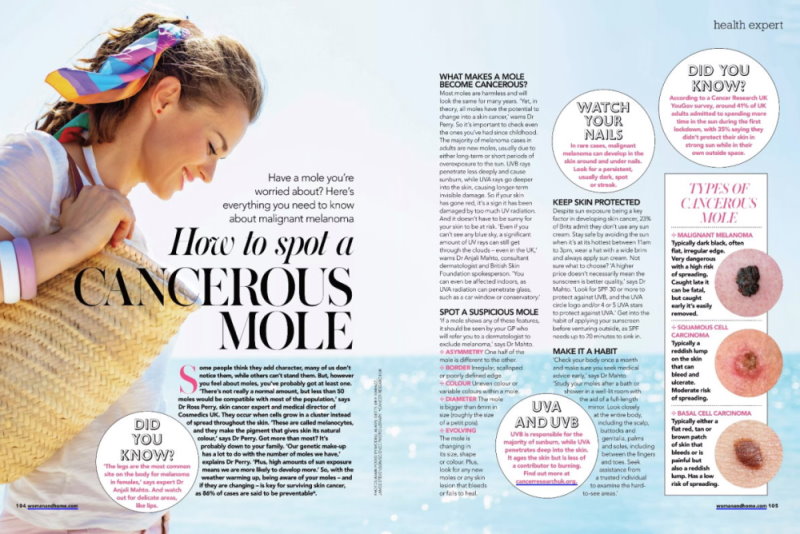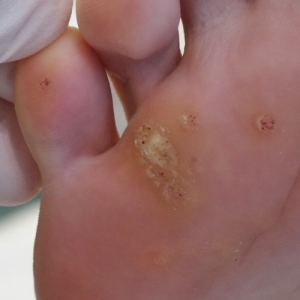 Verrucas (or verrucae) are simply warts that appear on the feet.
Verrucas (or verrucae) are simply warts that appear on the feet.
As with warts elsewhere on the body, they’re caused by the human papilloma virus (HPV). Unfortunately, this is a highly contagious virus, so they’re easily caught and easily spread too. This doesn’t only mean passing on verruca to other people, but also finding that the verrucae spread – multiplying on the feet or appearing as warts on other areas of the body.
The fact that the verruca virus is so contagious means that having verrucas is a very common problem.
They’re not just unpleasant to look at. A verruca can also be quite painful and uncomfortable; especially if it’s hard and presses into the foot when you walk or run.
If you someone you know has a verruca, it’s best to try and avoid it. If you have a verruca yourself, it’s best to deal with it to avoid it spreading further. You’ll also feel better too, without the knobbly discomfort on your foot.
Avoiding Verrucas/Verrucae
- Don’t go barefoot in public places. Wear flip flops where possible at the swimming pool, in communal showers or gym changing rooms
- Don’t share towels, socks or shoes with someone who has a verruca
- Change your socks every day
- Avoid touching other people’s warts or verrucas
- Keep the feet dry, as wet feet are more at risk of getting HPV
Avoid Spreading Verrucas/Warts
If you already have a verruca, here are some suggestions to avoid passing it on:
- Wear special verruca socks when swimming etc
- Wear flip flops in any shared showers – this includes at home as well as the pool/gym
- Cover verrucas with waterproof plasters
- Treat the verruca as quickly as possible to avoid it spreading to other parts of the body or other people. Verrucas are easiest to treat before they become too established. Once they are enlarged or hardened, they can be very painful to walk on too
DIY Verruca Treatments
At home treatments can be purchased from the chemist. Over the counter remedies are stronger than the ones available on the shelf, but they are still not effective on all verruca. Some are very resistant to treatment, especially when they’ve been allowed to get well-established.
For aggressive/resistant verrucas, professional treatment is advised.
Professional Treatments
The London Mole Removal Centre is a private company, offering treatment for unwanted moles and other skin lesions (cysts, skin tags, warts, verruca, lipoma etc).
Verruca treatments are carried out by doctors who are specially trained in the latest skin surgery techniques and are highly experienced in the field.
Verruca removal is carried out using a range of methods, depending on the severity of the condition. Our doctors may use cryotherapy (freezing), laser (or microcautery), or even surgery for the most difficult cases. Cryotherapy (freezing) and laser may involve 2-3 treatments to ensure complete removal of the foot warts, especially for the longer established verrucas.
Advantages of private treatment at the London Mole Removal Centre include:
- No waiting lists
- Choice of clinics in London and also Bristol
Book an Appointment
London Mole Removal Centre offer appointments at a choice of 5 private skin treatment centres based in London and Bristol. All consultations and treatments are carried out in person by doctors who are specially trained in the latest laser and skin surgery techniques and are highly experienced in the field. Most skin lesions can be removed at the same appointment as the consultation, but there is no obligation to proceed unless and until both the patient and doctor are completely happy to do so.
For more information or to book a consultation, please complete the form on this web page or call 020 7731 3791.
One of the most commonly asked questions for people researching or considering a skin treatment or procedure is the price.
The cost of having something done is an important factor, but not the only one and not the most important either.
Mole Removal Costs
Prices updated September 2023
At the London Mole Removal Clinic (Cosmedics Skin Clinics), we try very hard to be transparent about our pricing, as well as offering good value. Other providers may charge less, but we also know that many others will charge considerably more. It is important to understand exactly what service you will receive.
Simple mole removal starts at £345. This is based on removal of a single mole using laser or shave excision techniques. This is a straightforward procedure which is carried out using local anaesthetic to ensure that it is pain-free. We work hard to minimise scarring and this is a great method for providing a good result.
If you’re having several moles removed, there is a saving for subsequent moles that are removed in the same treatment session; so additional moles are removed at just £180. Many patients choose to have a number of moles removed at once to take advantage of the saving, as well as it being more convenient.
Larger or more complex moles may require a different procedure. Ellipse excision is a slightly more involved surgical technique and this will require stitches. Mole removal by ellipse excision starts at £500, with prices increasing for larger moles.
An additional fee is payable for mole testing (histology), which is recommended by our experts. This is especially important for any changing or pigmented moles, to check for any abnormal cells; but we recommend it for all moles as best practice.
In addition, there is a fee for £75 consultation, although this is waived if the treatment is carried out in the same appointment, saving a return visit.
Prices provided on our website are a guide only and subject to confirmation at consultation. Our doctors/surgeons need to have inspected the mole in person in order to confirm the exact cost.
Mole Removal Providers
Here are a few things to consider for those choosing a mole removal provider.
- What is the procedure? Some beauty salons offer mole removal with laser, IPL or electrolysis equipment. This is not recommended. The moles will not be sent for testing and the practitioner is unlikely to be medically qualified.
- Who is carrying it out? It is advisable to choose a medically qualified practitioner, who can spot any worrying signs as well as being able to remove the mole safely using appropriate medical techniques.
- How much experience do they have? A person who specialises in mole removal and carries out hundreds of techniques on a regular basis is likely to be more reliable than a person whose expertise lies elsewhere.
- Where is the procedure held? Cosmedics Skin Clinics has a number of mole removal centres – clinics where doctors specialise in the procedure. They are all CQC registered and work to high clinical standards. Be wary of any provider who does not have CQC registration.
- Can I get it free? The NHS may remove a mole free of charge, but this is usually only in the case of ‘suspicious’ moles, which are deemed to be at risk of being cancerous. If you have concern about a mole, then the NHS is a good route and referral should be quick. See your GP and if they agree, you’ll be referred to a specialist. Sadly, if the mole is deemed to be cosmetic, then private treatment is the way to get it removed.
Private Mole Removal
The London Mole Removal Centre is a private company, offering diagnosis and treatment for skin lesions including moles, cysts, skin tags, warts, verruca, lipoma, xanthelasma, milia. All consultations and treatments are carried out in person by doctors who are specially trained in the latest laser and skin surgery techniques and are highly experienced in the field. Patients benefit from:
- No waiting lists
- Fully trained doctors/surgeons, registered with GMC
- Blemishes can usually be removed in the same appointment as the consultation, saving the need for a repeat visit and allowing patients to get very quick treatment
- Choice of 4 clinics in London plus one in Bristol
- Testing with report provided where necessary
For more information or to book a consultation, please complete the form on this web page or call 020 7731 3791.
 Many patients are keen to understand whether they may be entitled to free mole removal on the NHS before they jump in and pay for it themselves privately.
Many patients are keen to understand whether they may be entitled to free mole removal on the NHS before they jump in and pay for it themselves privately.
The answer to this is – it depends…
There are some circumstances where the NHS may remove a mole free of charge, but this tends to relate to ‘suspicious’ moles, which are deemed to be at risk of being cancerous.
The majority of moles are not of medical concern. In this case, they are classified as ‘cosmetic’ and treatment is very rarely available on the NHS nowadays for moles that are not considered to be of medical concern or risk.
NHS Removal of Cosmetic Moles
The NHS website states:
“In general, moles are not removed for cosmetic reasons. If you wish to have a mole removed for cosmetic reasons, then you would almost always need to have it removed privately and will be charged a fee.”
NHS Removal of Suspicious Moles
What’s the process?
Any patient who has concerns about a ‘worrying’ mole’ is advised to see the GP as soon as possible.
If the GP agrees that the mole is suspicious, they will refer the patient to a dermatologist (skin specialist) for an expert assessment. After examination, if the dermatologist thinks that a mole has any abnormal or cancerous cells, they will arrange to remove the mole and this will include a test to see whether there were any abnormal cells.
Signs of a ‘worrying’ mole could include changes shape, colour or behaviour; or just a mole that looks unusual or ‘wrong’.
It is always best to get odd or suspicious moles checked out. If the NHS agrees that they are concerning, they will be removed very quickly and free of charge. The reason for this is to minimise any risk of the cancerous cells spreading.
If your mole turns out not to be worrying and therefore ineligible for removal on the NHS, then private mole removal presents another route. No referrals are required and removal is swift and pain-free.
Private Mole Removal
The London Mole Removal Centre is a private company, offering treatment for unwanted moles and other skin lesions (cysts, skin tags, warts, verruca, lipoma etc).
All treatments are carried out by doctors who are specially trained in the latest laser and skin surgery techniques and are highly experienced in the field.
Further advantages of private treatment at the London Mole Removal Centre include:
- No waiting lists
- Choice of clinics in London and also Bristol
- Removed moles tested with report provided
Mole Removal and Skin Blemishes
The London Mole Removal Centre offers a range of treatments designed for dealing with unwanted moles, cysts, warts, skin tags and other skin blemishes.
All treatments are carried out by skilled and experienced doctors and surgeons.
For more information or to book a consultation, please complete the form on this web page or call 020 7731 3791.
 Moles are small, coloured spots on the skin that can appear over time. They are a normal and natural skin condition and most people will have a number of moles.
Moles are small, coloured spots on the skin that can appear over time. They are a normal and natural skin condition and most people will have a number of moles.
Some moles exist from the day you were born, while others develop with age and especially as a consequence of sun exposure. They are mostly formed by a type of cell known as a melanocyte.
Although most moles are safe, some can be very dangerous. Therefore, it is good to know when you should get a mole seen by a health expert and when it needs to be removed.
Changes shape
Should your mole change shape or become uneven, it could be a sign of a more serious issue. Melanoma and non-melanoma are forms of skin cancer that can initially look like an odd mole. If you notice a change in shape, then ensure to get it checked. It is important to get an expert mole check routinely so that you can ensure that they are healthy and not indicators of skin health issues.
Changes colour or changes to two colours
A mole should rarely change colour. If it does, or if it appears to develop a two tone discoloration, then those are signs of unusual behaviour. An examination will assess whether or not your mole is potentially harmful.
Starts itching, flaking or bleeding
An itching, flaking or bleeding mole is a sign that needs to be taken notice of. It could be purely irritation from a skincare product, laundry detergent, or material brushing the mole. However, these could also be signs of skin cancer, a much more worrying concern. The best course of action is to get it seen, in order to ensure it isn’t a worrisome skin condition and put your mind at rest.
Gets larger or more raised from the skin
Similar to a mole changing shape, if it becomes enlarged or suddenly appears to be more raised from the skin, then it’s time to get it checked. If t and catching/removing it before it gets worse and causes harm to the health of your skin.
How can I get rid of unwanted moles?
Any mole deemed risky is normally removed very quickly on the NHS and will then be tested to understand whether it was cancerous so that the need for further treatment may be assessed.
However, many moles are deemed to be ‘cosmetic’ in nature and when this is the case, free NHS treatment is now severely reduced.
Clients can choose to have moles removed privately at clinics such as the London Mole Removal centre, who specialise in mole removal and also arrange full histology (testing) as a precautionary measure.
Private Mole Checks & Removal
The London Mole Removal Centre is a private company, offering diagnosis and treatment for skin lesions including moles, cysts, skin tags, warts, verruca, lipoma, xanthelasma, milia. All consultations and treatments are carried out in person by doctors who are specially trained in the latest laser and skin surgery techniques and are highly experienced in the field. Patients benefit from:
- No waiting lists
- Fully trained doctors, registered with GMC
- Blemishes can usually be removed in the same appointment as the consultation, saving the need for a repeat visit and allowing patients to get very quick treatment
- Choice of 4 clinics in London plus one in Bristol
- Testing with report provided where necessary
For more information or to book a consultation, please complete the form on this web page or call 020 7731 3791.
Dr Ross Perry, Media Health Expert
The Express featured expert advice on the TikTok trend ‘scalp popping’ from Dr Ross Perry, Founder and Medical Director of the London Mole Removal Centre.
Dr Perry joined other medical experts who advise against the hair pulling trend, which sees users create a noticeable popping sound on the scalp by sharply pulling sections of hair.
The Express article explained:
“The popping sound that you can hear is caused by the galea aponeurotic. This is a soft sheet of tissue connected to your scalp.”
Dr Perry strongly advised against detaching the galea aponeurotic from the scalp.
“Firstly you can easily tear the inside of the scalp which can lead to bleeding and possible infections, it can become sore and extremely uncomfortable.”
In addition, this could then result in hair loss, as the practise could
“…cause damage to the hair follicle on a long term basis.”
He said it could even result in damage to the neck and head, due to the
“Force of the hair being pulled.”
Ross concluded:
“In my opinion, it just isn’t even worth attempting.”
Read this article in full
To read more, please visit https://www.express.co.uk/life-style/health/1505906/Scalp-popping-warning-tiktok-trend-evg.
 Dr Ross Perry
Dr Ross Perry
Dr Perry is renowned as an expert in removal of skin lesions. He has removed thousands of moles in his role as Medical Director and founder of Cosmedics Skin Clinics including the London mole Removal Centre.
His career includes working in the NHS both in skin cancer reconstruction and as a GP, so he is experienced and expert in diagnosing skin lesions and providing the best possible advice/treatment.
Scalp Treatments
Dr Ross Perry has removed a number of skin lesions from the scalp and understands the delicate nature of the skin tissue in this area. The following photo shows cyst removal on scalp, all of which were carried out as day case procedures on a ‘walk in walk out’ basis in London, using local anaesthetic.
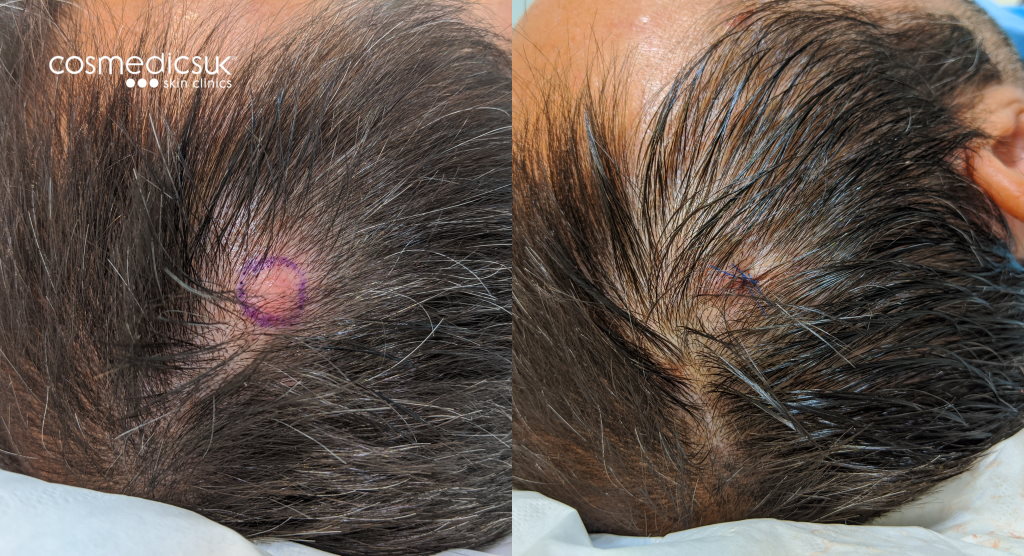
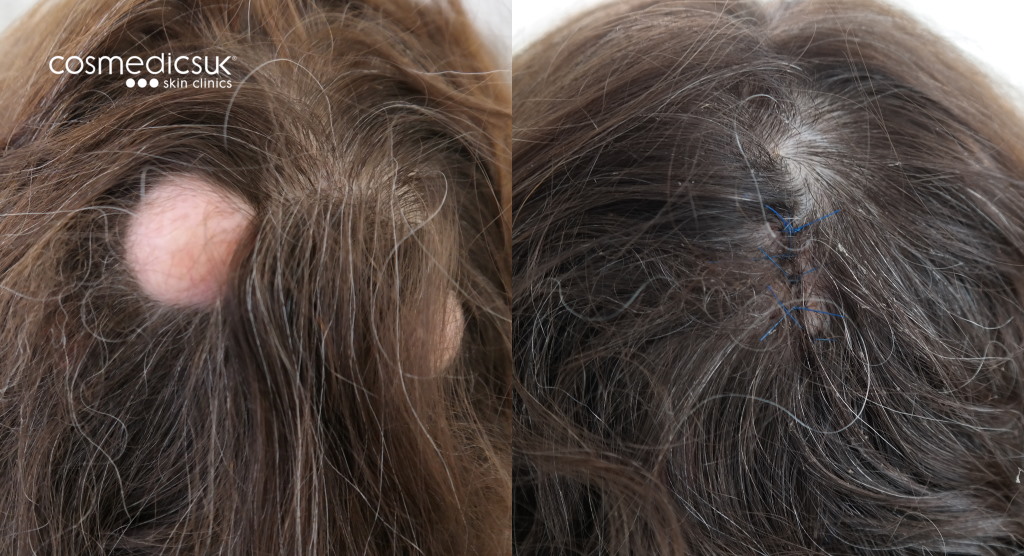
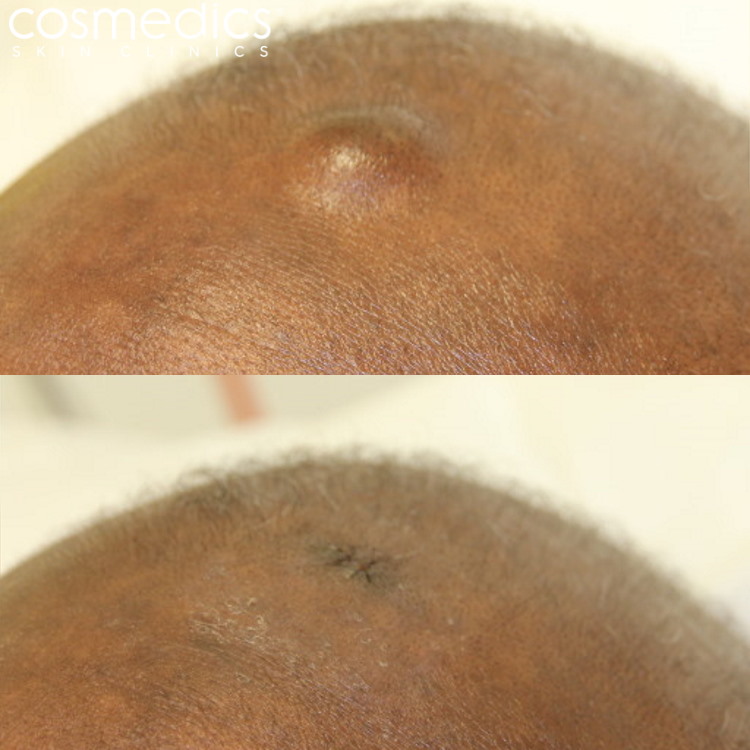
Clients can choose to have cysts removed privately at London Mole Removal centre clinics. The team also offers mole removal and also arrange full histology (testing) as a precautionary measure in case of any suspicious lesions.
Private Mole Checks & Removal
The London Mole Removal Centre is a private company, offering diagnosis and treatment for skin lesions including moles, cysts, skin tags, warts, verruca, lipoma, xanthelasma, milia. All consultations and treatments are carried out in person by doctors who are specially trained in the latest laser and skin surgery techniques and are highly experienced in the field. Patients benefit from:
- No waiting lists
- Fully trained doctors, registered with GMC
- Blemishes can usually be removed in the same appointment as the consultation, saving the need for a repeat visit and allowing patients to get very quick treatment
- Choice of 4 clinics in London plus one in Bristol
- Testing with report provided where necessary
For more information or to book a consultation, please complete the form on this web page or call 020 7731 3791.
Skincare & Tweakments Journalist
Founder of thetweakmentsguide.com
Alice Hart-Davis shared her experience of having a mole check at Cosmedics Skin Clinics with Dr Ross Perry in a video that has been viewed over 26k times already on YouTube.
She says:
“So I went for a mole-check with Dr Ross Perry of Cosmedics (before you ask, he’s not a dermatologist, but is a GP with a special interest in dermatology and many years experience at managing skin conditions).
“This video is him talking me through what we all need to know about moles, and particularly about checking our own moles, and how often we need to do it. What we need to keep an eye out for is a new mole, or a mole that’s growing fast, or suddenly looking different, and they can be anywhere from the hairline to the soles of our feet.
“Also, how much sun exposure do we need to get for vitamin D production, and how do we balance that with protecting our skin from the sun.”
Types of skin cancer
Dr Perry explains:
“There are basically 2 types of skin cancer.
“There’s melanoma skin cancer, which is the dark ugly moles, and those are the ones that are most worrying… they’re the ones that can spread and ultimately the ones that are are more likely to cause problems.
“You then have non-melanoma skin cancer, which is predominantly more related to chronic sun exposure. So that typically occurs in fair skinned individuals and that does occur in sun-exposed sites, so your face, your arms, your shoulders and particularly episodes of sunburn.”
He continues:
“so many more people having skin cancer, not necessarily melanoma, but non-melanoma skin cancers because people are living longer and they’ve had chronic exposure to sun, particularly the baby boomer era, and so as a result we’re seeing a lot more of these types of skin cancers.”
“The melanoma type of skin cancer is also rising as well, but not at the same rate that it once was and we’re diagnosing the moles earlier, purely on the basis that people’s awareness is much better now.
“…melanoma is still going up, but the rate of our detection is going up as well. We’re catching them much earlier now than we ever used to, so actually the mortality rate of melanoma is relatively stable.
How to spot a melanoma
Dr Ross Perry explains:
“Most people have these preconceptions of what a melanoma is; and that is often an itchy mole that sticks out of the skin, and that’s what most patients will come in and say ‘I’ve got this bobbly mole that’s irritating and itchy, is that the worrying one’
“Often in cases it’s on an area that rubs or itches and causes that type of discomfort. Those are not really the worrying moles. The worrying moles tend to be the new moles that you’ve never seen before, that are flat and dark. 70% of all melanomas are a brand new moles. So 30% of them are from an existing mole, however, you’re more likely to get a brand new mole that is going to develop into a melanoma – and that’s one thing that people just don’t realise. So when they’re looking at their moles they’re always looking at the old moles; but actually what we’re looking for is a brand new mole that is changing more rapidly.”
Ross says that the best way to identify a worrying mole is often by comparing it to the normal ones you are already familiar with. He goes on:
“I think for the majority of us who have just a few moles, you’re going to be able to see what’s an abnormal mole by comparing it to your other moles and so that’s why when normally should be examining yourself you should then basically be in front of the mirror in your underwear or having just got out of the shower so you can compare them, that’s the beauty of having moles on your body – you can compare all the ones that you do have as existing moles vs any potential new ones.
“What you’re looking for is what we call the ‘ugly duckling’ sign – so it’s the mole that just looks different from all your other moles and that has changed quicker than all your other moles.”
He stressed that melanomas can appear anywhere on the body as they are not directly caused by sun exposure – that’s why it’s so important to check thoroughly everywhere.
“You do need to just be aware of your whole body and that’s something I always suggest to patients that they check themselves every 2-3 months and it only takes 30 seconds literally looking everywhere and it’s always the innocuous areas that patients can turn up to our clinics in – back of the arm, inner part of the thigh – all these sorts of areas the patients don’t ever look at.”
What to do in case of a suspicious mole
Alice asked what people should do if they found something worrying and had concerns about their skin. Ross replied:
“In the initial instance, the GPs are always a good starting point and if the GPs are worries, because there are so many moles that people can be worried about it’s a minefield in terms of trying to decipher the nuances of what’s an abnormal mole vs a normal mole. GPs have a basic training which will basically give them a filter to refer onwards.
“If patients are worried and they’ve seen their GP, been reassured it’s OK – if things are still not resolving or they’re getting worse or changing shape or size then they need to revisit them and then push their point a little bit more if they’re concerned.”
Tweakments Practitioner
Alice Hart-Davis concludes:
“Alongside mole-spotting, Dr Perry is also a dab hand at non-surgical cosmetic procedures, and you’ll find him on my register on www.thetweakmentsguide.com.”
Read in full at https://thetweakmentsguide.com/practitioners/dr-ross-perry/
 Dr Ross Perry
Dr Ross Perry
Dr Perry is renowned as an expert in removal of skin lesions. He has removed thousands of moles in his role as Medical Director and founder of Cosmedics Skin Clinics including the London mole Removal Centre.
His career includes working in the NHS both in skin cancer reconstruction and as a GP, so he is experienced and expert in diagnosing skin lesions and providing the best possible advice/treatment.
Private Mole Checks & Removal
The London Mole Removal Centre is a private company, offering diagnosis and treatment for skin lesions including moles, cysts, skin tags, warts, verruca, lipoma, xanthelasma, milia. All consultations and treatments are carried out in person by doctors who are specially trained in the latest laser and skin surgery techniques and are highly experienced in the field. Patients benefit from:
- No waiting lists
- Fully trained doctors, registered with GMC
- Blemishes can usually be removed in the same appointment as the consultation, saving the need for a repeat visit and allowing patients to get very quick treatment
- Choice of 4 clinics in London plus one in Bristol
- Testing with report provided where necessary
For more information or to book a consultation, please complete the form on this web page or call 020 7731 3791.
As seen in Woman & Home
Popular women’s magazine Woman & Home provided its readers with expert advice from Dr Ross Perry on how to spot a cancerous mole.
Dr Ross Perry is Founder and Medical Director of the London Mole Removal Centre. He works in the NHS as a GP and skin cancer reconstruction expert as well as providing mole checks and mole removal at Cosmedics’ London Mole Removal Centres.
He told the publication that moles occur when cells grow in a cluster instead of spread throughout the skin:
“These are called melanocytes and they make the pigment that gives skin its natural colour.”
So why do some people have more moles than others?
“Our genetic make-up has a lot to do with the number of moles we have. Plus high amounts of sun exposure means we’re likely to develop more.”
The majority of moles are quite harmless, but Dr Perry warns:
“In theory, all moles have the potential to change into a skin cancer.”
However, most melanoma cases relate to new moles and are usually attributable to overexposure to the sun’s harmful UVA rays.
It is therefore important to be vigilant for any changing or new moles.
Mole Checking ABCDE
The Woman & Home feature summarises the potential characteristics of an ‘abnormal’ mole. It could be one or more of the following:
- Asymmetry: distorted or uneven shape
- Border: irregular or jagged edge.
- Colour: patchy or unusual colouration
- Diameter: unusually large – over 6mm across
- Evolving: changes in size, shape or colour – or behaviour e.g. discharge, itchy, bleeding
Dr Ross Perry always advises patients to be alert to the the ‘ugly duckling’ sign – the ‘odd one out’ that makes a mole different to the others.
In case of concern, the first step is to visit the GP to assess the mole and either rule out skin cancer or arrange a referral as appropriate.
Read more at https://www.womanandhome.com/health-and-wellbeing/health/cancerous-moles-signs-skin-cancer-321219/.
 Dr Ross Perry
Dr Ross Perry
Dr Perry is renowned as an expert in removal of skin lesions. He has removed thousands of moles in his role as Medical Director and founder of Cosmedics Skin Clinics including the London mole Removal Centre.
His career includes working in the NHS both in skin cancer reconstruction and as a GP, so he is experienced and expert in diagnosing skin lesions and providing the best possible advice/treatment.
Can I get rid of unwanted moles?
Any mole deemed risky is normally removed very quickly on the NHS and will then be tested to understand whether it was cancerous so that the need for further treatment may be assessed.
However, many moles are deemed to be ‘cosmetic’ in nature and when this is the case, free NHS treatment is now severely reduced.
Clients can choose to have moles removed privately at clinics such as the London Mole Removal centre, who specialise in mole removal and also arrange full histology (testing) as a precautionary measure.
Private Mole Checks & Removal
The London Mole Removal Centre is a private company, offering diagnosis and treatment for skin lesions including moles, cysts, skin tags, warts, verruca, lipoma, xanthelasma, milia. All consultations and treatments are carried out in person by doctors who are specially trained in the latest laser and skin surgery techniques and are highly experienced in the field. Patients benefit from:
- No waiting lists
- Fully trained doctors, registered with GMC
- Blemishes can usually be removed in the same appointment as the consultation, saving the need for a repeat visit and allowing patients to get very quick treatment
- Choice of 4 clinics in London plus one in Bristol
- Testing with report provided where necessary
For more information or to book a consultation, please complete the form on this web page or call 020 7731 3791.
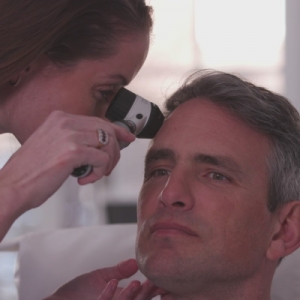
London Mole Removal Centre has produced a new video to showcase the range of treatments for removing unwanted moles and other skin ‘lumps and bumps’.
As the name implies, the clinic is best known for treatment of unwanted moles, but our doctors and surgeons treat all kinds of skin blemishes and lesions, including cysts, warts and skin tags, xanthelasma, milia and sebeceous hyperplasia to name but a few.
With clinics in London and Bristol, clients can expect fabulous service and true expertise that considers every detail of the experience for maximum satisfaction.
Video
Same day treatment for moles, warts, skin tags and cysts
GP Dr Ross Perry MBBS introduces the services:
“Our team of doctors are able to provide same-day treatments for moles, warts, skin tags and cysts.”
Consultant Surgeon Mr Michail Malandrakis FEBOPHTH L7CERT(AESTH) continues:
“Mole removal is one of the most popular procedures we perform here.
“A typical mole removal takes about 15 to 30 minutes. There’s minimal scarring.”
Cosmetic Surgeon Ms Aoife Turner MB Bch BAO FA, EBOPRAS says:
“Here at Cosmedics all our doctors and surgeons have a wealth of experience.”
She explains the clinics’ unique ‘See & Treat’ approach, which allows patients to go ahead and have their mole removed in the same appointment as the consultation if they wish, making it a convenient and efficient service:
“The doctor you meet for your consultation will be the doctor who carries out your procedure and many procedures can be carried out on the same day.
“After your procedure we’ll make sure you’re feeling OK and we’ll go through all the relevant aftercare information and make an appointment for your follow-up.”
Dr Perry says:
“We’re able to use a wide variety of treatment options depending on the condition that you’ve come in with; whether it be a mole or a wart or a skin tag.”
He explains that carefully chosen techniques are used in order to leave minimal scarring after healing:
“We use a wide range of technologies in order to ensure that we give you the best results.
“This can range from laser through to radio surgery and even occasionally microwave treatments.”
He adds that these procedures are pain-free, so patients don’t need to worry about them hurting:
“These are all generally carried out under local anaesthetic to ensure that the area that we’re treating is numb and that you don’t feel any discomfort during the procedure.”
Ms Turner concludes:
“If you’re suffering with a mole that’s bothering you from a cosmetic point of view, if it’s getting irritated or you’re worried about it from a medical standpoint; here at Cosmedics we can offer you the latest technology to remove it with minimal scarring and next to no downtime.”
Private Mole Checks & Removal
The London Mole Removal Centre is a private company, offering private mole checks and mole removal treatment for unwanted moles. The experienced doctors and surgeons also offer removal treatment for a range of other skin lesions (e.g. cysts, skin tags, warts, verruca, lipoma, xanthelasma).
All consultations and treatments are carried out in person by doctors who are specially trained in the latest laser and skin surgery techniques and are highly experienced in the field.
Further advantages of private treatment at the London Mole Removal Centre include:
- No waiting lists
- Fully trained doctors, registered with GMC
- Moles can often be removed in the same appointment as the consultation, saving the need for a repeat visit and allowing patients to get their skin lesions removed very quickly
- Choice of 4 clinics in London and also Bristol
- Removed moles tested with report provided
For more information or to book a consultation, please complete the form on this web page or call 020 7731 3791.
 It can be hard to tell the difference between vaginal skin tags and genital warts. They can look and feel similar – and they are both often distressing as well as annoying.
It can be hard to tell the difference between vaginal skin tags and genital warts. They can look and feel similar – and they are both often distressing as well as annoying.
The key difference is that warts are contagious. If you have genital warts, then you’ve caught them from somebody and are at risk of passing them on too.
Skin tags are benign flaps of skin and are not contagious, but can be nonetheless annoying and distressing.
Genital Warts
Genital warts are a symptom of HPV (human papillomavirus).
They tend to appear in a patch with several lumpy bumps of skin.
HPV is a very common sexually transmitted disease. When genital warts appear, they can be very irritating and can cause pain, discomfort, and itching; although sometimes they are only annoying in a cosmetic way due to their appearance (which in itself can cause great concern).
Genital warts can also be embarrassing and cause awkwardness with partners.
Vaginal Skin Tags
Vaginal skin tags are tiny flaps of skin that appear in the vaginal area. They are thought to develop due to friction i.e. clothing or rubbing skin causing overgrowth of the skin, which develops into protruding skin tags. They can sometimes develop during pregnancy or as a consequence of weight gain.
Skin tags are not contagious at all, but as with genital warts, the appearance of them can be very upsetting and worrying for clients.
Diagnosing Skin Lesions
If you are concerned about genital warts or vaginal skin tags, it is best to get a proper diagnosis, so that you can understand your treatment options. These lesions tend to be fairly small and are not in an area that you can easily see, which makes it difficult to self-diagnose.
It is best to consult a doctor or specialist for advice.
The NHS offers free sexual health clinics where they can carry out a full set of screening tests for STD’s (sexually transmitted diseases) or STI’s (sexually transmitted infections). Find sexual health clinic contact details.
However, the resources to treat patients are limited. Treatments offered tend to be topical i.e. creams or liquids, which can take a long time to work and can also cause irritation. surgery or freezing (cryotherapy) tend to be more efficient means of treatment for genital warts; but are not always available on the NHS.
The NHS doesn’t tend to offer treatment for vaginal skin tags as they are classed as a cosmetic issue, rather than a medical problem.
Private clinic treatments for genital warts and vaginal skin tags
Doctors and surgeons at Cosmedics’ London Mole Removal Centre offer treatment for both genital warts and vaginal skin tags. They can often provide same day treatment through their ‘See & Treat’ service.
- Cryotherapy (freezing) – Simple warts or skin tags are frozen off in a procedure known as ‘cryotherapy’ which uses intense cold to destroy the growth. Treatment may involve 2-3 sessions to ensure complete removal of the wart.
- Laser or skin surgery – Large and resistant warts or skin tags can be treated either using more aggressive techniques, involving laser or surgery with cauterisation to seal the wound. Usually treatment can be completed in just one session.
Treatments are completely pain-free thanks to use of modern local anaesthetic. Patients are provided with full aftercare guidance and a followup appointment is included where recommended.
Book an Appointment
London Mole Removal Centre offer appointments at a choice of 5 private skin treatment centres based in London and Bristol. All consultations and treatments are carried out in person by doctors who are specially trained in the latest laser and skin surgery techniques and are highly experienced in the field. Most skin lesions can be removed at the same appointment as the consultation, but there is no obligation to proceed unless and until both the patient and doctor are completely happy to do so.
For more information or to book a consultation, please complete the form on this web page or call 020 7731 3791.
London Mole Removal Centre
The London Mole Removal Centre offers private treatment for removal of moles, skin tags, warts, cysts and other lesions by skilled doctors and surgeons.
No waiting lists and same day treatment.

